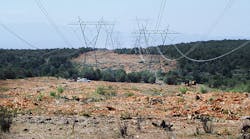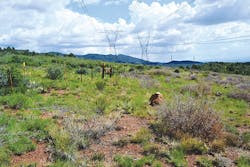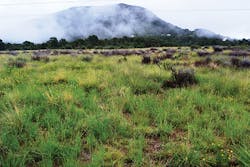Herbicides tend to get a bad rap. And with an ever-increasing focus on sustainability and environmentalism in the U.S., that should not come as a surprise. From the widespread tendency to misuse and overuse herbicides and pesticides in the 1960s and 1970s to Rachel Carson’s watershed documentation in her book Silent Spring about the negative effects of pesticides on the environment, people approach herbicide and pesticide use with an earned skepticism. Often overlooked, however, Carson references the judicial use by the utility industry of low-volume herbicides applied with knapsack sprayers as a recommended technique. To be quite frank, the utility industry has been doing this right for some time.
Today, herbicides go through rigorous oversight approvals. Herbicides for use on utility corridors are now measured in ounces per acre as opposed to gallons per acre. There is simply more knowledge, skill level and technology to apply herbicides responsibly for the betterment of the environment. All it takes is the adherence to some simple best practices.
A herbicide program undertaken by Arizona Public Service (APS) in recent years is a good case study in the successful development and deployment of an integrated vegetation management (IVM) program that incorporates the selective use of herbicides at low volumes. The program not only helped with the utility’s maintenance needs, but also enabled it to realize significant benefits that would have otherwise gone unnoticed.
An APS Example
The strategies used at APS are relatively simple, responsible and can be applied across many different geographies. Following are the steps of the process.
• Defining IVM when talking select herbicide use. It is helpful to begin with a definition of IVM. Per Part 7 of the American National Standards Institute (ANSI) A300 standard, IVM is defined as a system of managing plant communities in which managers set objectives, identify compatible and incompatible vegetation, and evaluate, select and implement the most appropriate control methods to achieve their objectives.
Preventing plant communities from interfering with the operation of electrical facilities is the first priority. Therefore, an IVM program should take the most effective measures to prevent such interference from happening. Depending on the local environment, the selective use of herbicides is often found to be the most effective, sustainable and efficient way to accomplish that goal.
When properly managed, herbicides can help to foster diverse communities of plant life within the right-of-way (ROW). By helping to shape diverse plant ecosystems in these areas through responsible IVM practices, utilities can protect their electrical facilities and reduce overall maintenance needs, while shifting their thinking from ROW as sacrifices of thriving biological communities to areas of unique opportunity, enhancing wildlife habitats, forest ecology and aesthetic values.
• Enlist biological control. Some plant species pose far more of a threat than others within the ROW. While tall-growing tree species can pose a significant threat to power lines, grasses and early successional plant species can thrive without disrupting electrical facilities. Biological control seeks to give a competitive advantage to those benign plant species, granting them the sunlight, water and other resources needed to thrive while suppressing tree species from becoming established.
Herbicides form an integral part of these biological control methods. At APS, a third-party vendor looked closely at several test plots in various ecosystems throughout Arizona. The team compared the outcome of a simple three-year mowing cycle versus the controlled use of herbicides at similar plots. What was discovered is striking. Within the three years, the herbicide test plots were covered with native grasses, while the mowed area was swathed in incompatible and invasive species. The results of the herbicide applications were not only beneficial for the electrical facilities, but they helped to foster a thriving ecological community in treated areas. By eliminating tall-growing species and giving the advantage to low-growing grasses, a multitude of benefits can result:
- Manual control for tall-growing species means cutting or mowing can be eliminated.
- Further targeting of low-growing invasives like buffelgrass and other fire-prone species helps to reduce the risk of wildfire, boosting electric grid reliability.
- On-target grasses and wildflowers are allowed to flourish, becoming important pollinators by bringing in wildlife species like bees, hummingbirds and butterflies.
- Dead stems and trunks from targeted tree species can become habitats for bees and other insects.
It is a clear demonstration of what responsible herbicide use can accomplish: a reduced need for maintenance as well as a proactive way to help mitigate the risk of wildfires in communities, helping utilities to boost safety and overall reliability. When made part of a holistic IVM program, herbicides can be used selectively to manage problematic species after an initial mechanical clearing of the ROW.
•Use hands-on best practices. A successful IVM program that takes advantage of biological control methods begins with a handful of basic best practices at the real-world application level. When it comes to herbicide use, careful application is successful application. Several steps can be taken to ensure field workers are following proper application practices.
Advancements in herbicide and carrier technology today mean utilities and IVM professionals can deploy herbicides at lower volumes than ever before. Low-volume carrier products enable the treatment of greater areas with less total herbicide, minimizing environmental impact while successfully and efficiently treating overgrowth and incompatible plant species throughout ROW. This should be considered in any sophisticated IVM program.
Next, following the Utility Arborist Association’s Best Management Practice on Closed Chain of Custody for Herbicides is an effective way to procure herbicides for field use. The guide outlines the important components of a good herbicide plan, including the use of returnable/refillable supply containers, tracking systems and custom blending.
Following closed chain-of-custody protocol is beneficial for a few reasons. With a closed system, field workers are not responsible for mixing herbicides while in the field; a third party has already done the careful work beforehand, ensuring an accurate percentage of herbicides.
Returnable/refillable containers eliminate the disposal of plastic jugs, cardboard and pallets used if mixed in the field, therefore reducing waste that goes in the landfill. When returnable/refillable containers are no longer usable, they are recycled.
From a safety perspective, the closed chain-of-custody approach reduces the chances a worker or unintended parts of the environment are accidentally exposed to herbicides. When the worker does not have to mix the product, it reduces the chance of spillage and the risk of exposing his or her eyes to the product.
Another important component for a more effective herbicide program is the choice of herbicide carrier. While it is common to use a simple mixture of water and the surfactant herbicide, a more effective carrier is often a paraffinic oil product. Paraffinic oils encapsulate droplets of herbicide, enabling a more uniform and concentrated application, helping to lower the volume of herbicides being used.
Paraffinic oils also help to reduce drift-upon application, which can become a significant challenge when herbicides are mixed with water. Further, a paraffinic oil helps to ensure herbicide applications are able to absorb into the plant more effectively. Where water mixtures can dry and evaporate quickly, especially in hot and dry climates like Arizona, a paraffinic oil is not as susceptible to evaporation, enabling the herbicides to absorb as needed. Paraffinic oil carriers also help to conserve significant amounts of water that would otherwise be required — again, helpful in hot and arid climates.
Reflections from the APS Study
What does a smart herbicide program look like overall? A realistic approach involves acceptance that 100% control on an initial application simply is not possible. People are human, after all; spots can be overlooked and inadvertent mistakes can happen.
What utilities can do is strive for near perfection on the first pass and make up for the differences as part of a follow-up approach. However, a well-run herbicide program can achieve a total 100% figure with a 90-10 approach This means over the course of the first year of a program, a utility can strive to achieve 90% control with touch-up control taking place over the following year, adding up to 100% control over two years.
The results of a two-year program can be astoundingly effective, typically not requiring follow-up treatment for an additional six to 10 years, with spot treatments performed only as necessary. Biological control methods do the work, considering a traditional mechanical method without the use of herbicides may only keep the ROW similarly clear for three years to five years. This IVM approach will reduce future maintenance costs significantly.
Think about that for a second, about how fewer hours can be spent hand-cutting and mowing vegetation. That is not only business efficiency but a major energy and resource efficiency. It means less gasoline consumption and reduced gasoline-powered machine emissions go into the atmosphere. It means that a utility’s maintenance crews can be put to better use than mowing and cutting a given corridor several times over. It also means these corridors can be put to better use, with promotion of beneficial species that foster ecological sustainability and benefit local wildlife.
Like any successful IVM program, effective communication by involving an organization’s key stakeholders is critical to making the most of a herbicide program. Those seeking to establish such a program should be armed with a strategic plan and working knowledge of how a herbicide program can make a significant impact on an overall IVM program. With those things, making a pitch comes much more easily.
Herbicides have come a long way over the years, and knowing how to properly use and deploy them can help make any IVM program that much more effective.
Mike Neal retired from Arizona Public Service and now serves as director of customer solutions for ACRT Inc. He is a past president of the International Society of Arboriculture, the Utility Arborist Association and the TREE Fund, and he served as chair of the Edison Electric Institute’s vegetation management task force.





